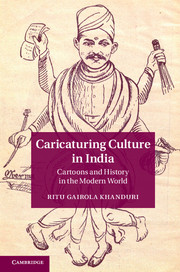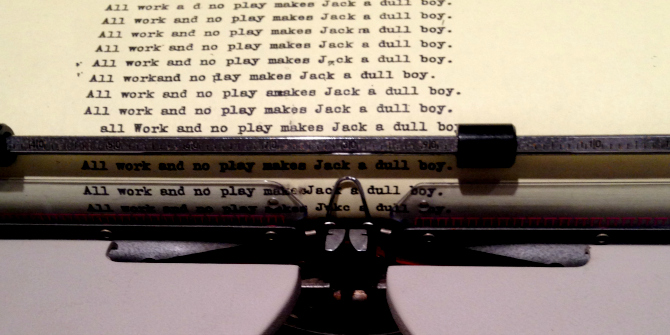A cross disciplinary examination of political cartooning in India raises questions regarding liberalism, modernity and the contrast between Western and local views. Caricaturing Culture in India: Cartoons and History in the Modern World offers examples of Indians who objected to cartoons not out of conservative squeamishness, but rather based on their liberal inclinations. The book is as much a history of political caricaturing in India as an interrogation of the contradictions at the heart of liberalism, writes Medha.
 Caricaturing Culture in India: Cartoons and History in the Modern World. Ritu Gairola Khanduri. Cambridge University Press. 2014.
Caricaturing Culture in India: Cartoons and History in the Modern World. Ritu Gairola Khanduri. Cambridge University Press. 2014.
In August 1925 when the London Star published a cartoon commemorating British cricketer Jack Hobbs’s 2000th test cricket run, little did the publisher or the cartoonist imagine that it would cause a furore in far-away India. The cartoon, drawn by now legendary caricaturist David Low, depicted Hobbs towering over an assortment of historical personalities: Adam, Julius Caesar, Charlie Chaplin, Muhammad, Columbus, and Lloyd George. The protestors in Calcutta called upon the colonial Government of India to compel the British government into censuring the magazine’s editor not just for showing the prophet among “lesser celebrities”, but for representing him at all. In the event the British government was unresponsive and the issue died down. The discourse surrounding the incident is, however, all too reminiscent of that surrounding the recent Charlie Hebdo massacre and the Danish Cartoon Controversy before that. Why do cartoons inspire such passions? This question lies at the heart of cultural anthropologist Ritu Gairola Khanduri’s Caricaturing Culture in India: Cartoons and History in the Modern World.
The book is as much a history of political caricaturing in India as an interrogation of the contradictions at the heart of liberalism. In tracing the history of newspaper cartooning in India from its beginnings in nineteenth century colonial India up to the animated debate that the Danish cartoons controversy of 2006 spurred in India, Khanduri, associate professor at the University of Texas at Arlington, draws out the thin boundary between amusement and affront that cartoons often traverse. By making explicit the discussion surrounding good taste and offence in cartoons, through archival research, memoirs, life histories and ethnographic observation she illustrates how “the refusal to laugh” is not so much an attack on values of liberalism as a resistance framed within liberalism itself.
An example of this is Rajkumari Amrit Kaur’s objections to depictions of educated women by Shankar, the staff cartoonist of the English language nationalist daily Hindustan Times, as out of touch and even morally vacuous. An anti-colonial activist, follower of Gandhi and a feminist, Amrit Kaur was committed to empowering the women in India “by educating and training them for a professional and public life.” The negative portrayals of educated women by Shankar, she felt, thwarted these efforts. Piecing together the reasons for her objections Khanduri shows that Amrit Kaur’s response cannot be read simplistically as a non-liberal effort at curbing freedom of expression. Rather, hers was “a modern liberal eye that would brook no caricature of religion and gender in the name of another modern sensibility—political humour at the cost of marginalized subjects.” Through various examples such as these, Khanduri shows that objections to cartoons are often part of the politics of representation and can be seen as attempts to reclaim subjectivity.
At the same time, the desire to police cartoons (and thus exclude the opportunity to engage in debate over their meanings), also betrays a sensibility that satire requires a certain social and cultural capital to grasp. This, as Khanduri points out, at least in the case of India, echoes a familiar colonial narrative. To give voice to British misgivings about reception of cartoons in colonial India Khanduri quotes Charles Dickens’ All the year round (1862): “Punch in India. The idea seems unpromising. A professed jest must surely be out of place among a people who have but little turn for comedy. The Asiatic temperament is solemn, and finds no enjoyment in fun for its own sake.” In the event, the popularity of the various vernacular appropriations of the British satirical magazine Punch in India, directly contradicted Dickens’ claims. However, these magazines did end up challenging the colonial state in other ways: in appropriating the British Punch as a template for humour aesthetics to critique colonial politics, these magazines offered a self-conscious challenge to British claims to liberal governance.
This notion that “only the initiated could collectively comprehend” cartoons, however, was not limited to colonial elites. As Khanduri reveals, it was also crucial to Gandhi’s early anti-colonial politics in South Africa. In the newspaper Indian Opinion that Gandhi edited in South Africa, he often reproduced English cartoons together with lengthy commentaries on their meaning. Through his interpretation of the cartoons’ meaning, Gandhi aimed to give his readers a peep into “the minds of the whites” (quotes in original), transforming the cartoons into political texts “for immigrant Indian readers to surreptitiously encroach upon the imperial mind”. On his return to India, he further kept an eye on cartoons drawn by Shankar and even arbitrated in case of disputes over intention and meaning. This reconstruction of Gandhi’s politics via his engagement with cartoons adds a new perspective to a much-studied topic and is a definite contribution that the book makes.
The lens of political cartooning culture offers Khanduri a new standpoint from which to examine the political historiography of India and its tryst with modernity. Meticulously tracing the production and reception of political cartoons across a nearly one hundred and fifty year period, Caricaturing Culture in India draws out the various ways in which cartoons have been used as sites for the negotiation of self and subjectivity within the context of liberalism. In doing so the book speaks to our current dilemmas and offers a much-needed counterpoint to debates about freedom of expression and democracy that, in the wake of the Danish cartoon controversy and the Charlie Hebdo massacre, have made cartoons “a litmus test for modernity and its others”. The book traverses several disciplinary boundaries and has much to offer to scholars of anthropology, history, politics, and media studies. To a researcher, one of the most compelling aspects of the book is the ways in which it makes the research process transparent: not concealing the author but making her reflections and interactions with her interlocutors and the material an intrinsic part of the narrative. This very self-conscious level of attention to detail, however, may make the book a wee bit tedious for a casual reader.
Medha is a research fellow/doctoral student at the German Institute for Global and Area Studies (GIGA), Hamburg. Her research focus is on the role of Islam in India’s identity and foreign policy. She holds an M.A. in Media Studies and has previously worked as a journalist in India, Germany, the Netherlands and Canada.








1 Comments